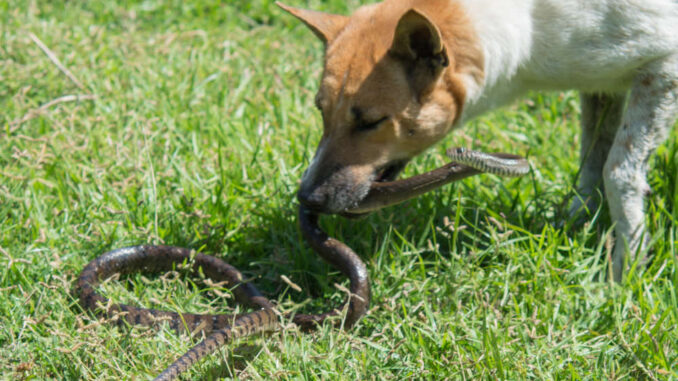
This article was updated on September 15th, 2023
Summer approaching and warm weather around the corner means lots of outside time for us and our canine companions. It also means snake bites become more of a possibility. Dogs are curious creatures and tend to investigate or surprise things that don’t want to be bothered, ie. snakes.
Depending on the type of snake and where they bite a dog, snake bites can be very serious, even fatal.
Since you may not always witness a snake biting your dog, it’s important to know what snake bites look like and what you should do about them. It’s even more important to know how to carefully avoid snake bites so that it hopefully never becomes an issue. We’ll cover all of that here.

How Dangerous is a Snake Bite for a Dog?
There are thousands of types of snakes out there in the world, most of which we don’t have to worry about. They’re more afraid of us than we are of them and prefer to keep their distance. However, there are those types that choose to fight back. The main species that are a concern to our dogs are the venomous Rattlesnake, Coral snake, Cottonmouth, and Copperhead. A bite from these can lead to significant swelling, tissue damage, and even systemic shock.
Nonvenomous snakes can bite too and still cause a reaction of swelling and pain. Usually, this reaction is confined to a small area around the bite which can be a problem if that area is in the nose or throat causing swelling that blocks the airways. Most of the time nonvenomous snake bites get better within a couple of days.
Signs of a Snake Bite on a Dog
Snake bites may be hard to differentiate from other types of wounds on dogs, but never rule it out as a possibility. Below is an image of a snake bite on a dog:

You can view more pictures of snake bites on dogs in our article: What snake bites look like on dogs [with pictures].
Identifying the type of snake that bit your dog can help predict the type of reaction he will have and if he needs immediate attention. If you don’t know what kind of snake was the culprit, watch for these signs:
- Nonvenomous snake bites usually have bruising and swelling at the site. You may or may not be able to see side-by-side puncture wounds. The wound is usually very painful, may bleed a little and has the potential to get infected.
- Venomous snake bites are also going to have swelling and blood, but the swelling is going to be much more severe, spreading well past the bite site. Puncture wounds may or may not be noticeable. Depending on the type of snake, dogs may become lethargic, tremble, shake, having vomiting, diarrhea or bloody urine, dilated pupils, paralysis, or weakness and collapse.
Most snake bites will be found on a dog’s head, neck, and feet since those are usually the first body parts to approach a snake. Here is another closeup picture of a snake bite on a dog’s foot:

How Long Does it Take for a Snake Bite to Affect a Dog?
Snake bites can cause immediate reactions or not show up for 24 hours. Most of the time, you’ll notice some swelling or redness within 30-60 minutes. Long-term organ damage affects, like bloody urine, may take longer to show up.
Can a Dog Survive a Snake Bite Without Treatment?
Dogs that get a snake bite from a nonvenomous snake are more likely to survive than those bitten by a venomous snake. However, nonvenomous snake bites aren’t without their major risks. If a dog is bitten on the nose or throat, the swelling can lead to a blockage of the airways and an emergency situation. Nonvenomous snake bites can also get infected if they aren’t treated properly.
Venomous snake bites respond best to immediate treatment. Most dogs will survive a venomous snake bite with proper care. Not getting treatment greatly reduces their survival rate.
How Do You Treat a Snake Bite on a Dog at Home?
If you suspect that your dog has been bitten by a snake, you should be in contact with your veterinarian. However, there are some immediate things you can do at home to help relieve the symptoms while you make your way to the vet.
- Stay calm: Snake bites on dogs are scary, no doubt about it, but panicking isn’t going to help your dog. Keep a cool head and call your vet.
- Wash the wound: Gently wash the area with soap and water and try to keep it below the heart. Keep your pup as calm and quiet as possible.
- Give antihistamines: Some vets may have you give an antihistamine, such as Benadryl, to help prevent an allergic reaction and reduce swelling.
- Cold compress: Applying a cool washcloth or covered cold pack to the bite site can help reduce swelling and pain.
If you are 100% positive the snake that bit your dog was nonvenomous and the location won’t cause life threatening issues, your vet may have you treat and monitor at home. However, it’s always better to play it safe and get some veterinary care for any and all types of snake bites.
When Do You Know a Snake Bite is Serious and Needs Vet Attention?
You’re always better off to see a veterinarian anytime you suspect that your dog was bitten by a snake. Even if you’re sure that the snake was nonvenomous, you don’t want to risk the chance of infection or life-threatening swelling.
That being said, seek immediate veterinary care if your dog is showing any other signs besides just swelling and pain. Difficulty breathing, weakness, shaking, drooling, vomiting or diarrhea are all signs of a systemic reaction to the venom. Most of these signs are going to show up within 30-60 minutes of a snake bite, but others, like bloody urine may take a day or two.
How Do Vets Treat Snake Bites on Dogs?

The treatment of snake bites on dogs is going to depend on the severity of the signs. Vets may administer antihistamines to prevent an allergic reaction and reduce swelling. They may need to give fluids to help combat shock and dehydration. Antibiotics and anti-inflammatories may be given to prevent infection and decrease pain. Oxygen may be used if a dog is having trouble breathing, and hospitalization is often required.
If the species of snake is known, antivenom may be given to counteract the poison. In some areas of the country, antivenom is given in all suspected snake bite cases since snake bites by certain species, mainly Rattlesnakes, are the most common.
You can help your vet by getting a picture of the snake, if possible, to better help them identify it. Don’t ever try to catch the snake since this may result in you getting bit as well. Tell your vet if you gave your pup any medication or started any treatment prior to arriving at the clinic.
How to Avoid Snake Bites on Dogs
The best way to avoid a snake bite on your dog is to avoid snakes all together. Makes sense, right? There are a couple ways to do this.
- Make your yard less snake-friendly: Keep grass and weeds cut short so that snakes can’t hide. Remove piles of rock, wood, or other items. Clean up rodent food sources so that mice don’t move in, attracting snakes.
- Keep your dog on a leash: If you hike or walk in snake-y areas, having your dog on a leash can help him mind his own business and keep his nose to themselves. Avoid walking near piles of rocks and brush, holes, and tall grass as well.
If you live in a high snake area, avoiding may not be possible. For these dogs, you may want to get some snake aversion training that will help him recognize the sight and sound of a snake so he’ll know to stay away. You may also consider having your dog vaccinated. Rattlesnake vaccines are available that can help reduce the severity of a snake bite should your pup get bitten.
Related Post:
Disclaimer: This website's content is not a substitute for veterinary care. Always consult with your veterinarian for healthcare decisions. Read More.




Be the first to comment